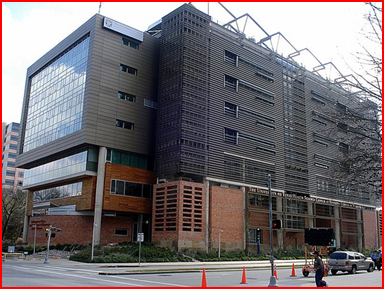The School of Nursing and Student Community Center at the University of Texas in Houston (pictured) was chosen as an AGS case study for several reasons, according to a very explicit piece by Rives Taylor in Architectural Graphic Standards, 11th Edition. Ambitious high-performance goals were set and met. It began with a holistic approach to design and planning:
These building strategies were developed through a highly defined and premeditated process in a one-year period before design started. A collective team of experts undertook this year of intensive research, seeking the best existing research methods, design, and operational practices to direct the realization of this facility.
One of the greenest things about the School of Nursing is what happened even before the first step toward its creation. The site had previously been occupied by a research building, which was deconstructed so conscientiously that 80% of its materials were reclaimed for recycling and eventual further use.
Building Information Modeling techniques were used to formulate an initial plan, which was then, with the aid of the software, changed and adjusted along the way. BIM helped with the validation of recycled content, the balancing of CO2, and assessment of the buildings life cycle, and in other areas as well. For instance, in the matter of lighting:
The team refined their intuitive ideas using energy and daylight modeling tools with the Lawrence Berkeley National Labs… Actual lighting levels for the alternative design schemes were simulated through a yearly cycle. The measurements were then compared and decisions were made to follow specific strategies based on light quality, quantity, energy performance, costs, and other criteria.
Maximum lighting effectiveness was achieved through a combination of several different solutions including windows, four skylighted atria, sun shading devices, and artificial lighting. Daylighting is characterized here as one of the most simple and powerful strategies, because it doesn’t require a trained operations staff in order to work effectively.
Some recycled materials were used, for instance the multi-layered insulation. All materials were closely scrutinized with an eye to their low volatile organic compound (VOC) content. Once set in place, these of course also continue to perform without further human intervention. For greater energy efficiency, HVAC (heating, ventilation and air conditioning) equipment was installed with a combination of some undersized elements (pumps and fans) and some over-sized ones (ducts and pipes). Ventilation is treated separately from cooling, and a localized instantaneous hot water delivery system is the solution preferred over the traditional central hot water source. The double-paned window glass is spectrally selective.
Five tanks collect rainwater which, combined with condensation from the cooling system, provide greywater for the low-flow toilets and other uses, while potable water is to be found only in drinking fountains, sinks and showers.
The first two floors contain facilities used by the whole student body: bookstore, auditorium, café, and student services offices. The third and fourth floors are dedicated to the academic needs of the nursing school: classrooms and other learning environments. Then there is a research lab floor, topped by three stories containing offices for faculty and administration, and conference rooms. The service building is a separate structure.
The School of Nursing’s four elevations and its roof were conceived as five unique facades, each a distinct entity, and the detail with which Taylor describes the individual design approaches to the conditions and requirements on the various sides, is the highlight of this chapter.
SOURCE: “University of Texas School of Nursing and Student Community Center” AGS page 495 2007
photo courtesy of JoeBehrPalmSprings , used under this Creative Commons license

0 Responses to “A High-Performance Building in Texas”